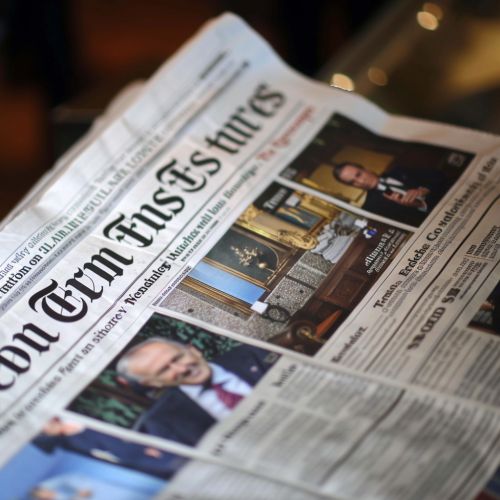The Financial Times
History
The Financial Times (FT) is an internationally recognized daily newspaper that focuses on business and economic news. It was first published in 1888 by James Sheridan and Horatio Bottomley, initially under the name the London Financial Guide. The name was changed to the Financial Times in 1889. The paper distinguished itself from its competitors by printing on light pink paper, a tradition that continues to this day. The FT has grown to become one of the most respected sources of financial news and analysis globally.
Ownership and Management
The Financial Times has undergone several changes in ownership throughout its history. Initially, it was independently owned until it was acquired by Pearson PLC in 1957. Pearson, a British multinational publishing and education company, retained ownership until 2015. In July 2015, Nikkei Inc., a Japanese media company, acquired the Financial Times for £844 million. The acquisition by Nikkei marked a significant shift, bringing the FT under the umbrella of one of Japan's largest media conglomerates.
Editorial Stance and Influence
The Financial Times is known for its centrist to center-right editorial stance, with a strong emphasis on free markets and economic liberalism. The newspaper has a reputation for rigorous journalism and in-depth analysis, making it a trusted source for business professionals, policymakers, and academics. The FT's editorial board has a significant influence on economic policy discussions and financial markets worldwide.
Content and Sections
The Financial Times covers a wide range of topics, including global news, financial markets, companies, technology, and lifestyle. The newspaper is divided into several sections:
News
The news section provides comprehensive coverage of global events, with a particular focus on economic and political developments. This section includes articles on major geopolitical events, policy changes, and significant market movements.
Companies
The companies section offers detailed analysis of major corporations, including financial performance, strategic developments, and leadership changes. This section is particularly valuable for investors and business professionals seeking insights into corporate strategies and market trends.
Markets
The markets section covers financial markets, including equities, bonds, commodities, and foreign exchange. It provides real-time data, analysis, and commentary on market movements and trends.
Opinion
The opinion section features editorials, columns, and guest articles from experts in various fields. This section provides diverse perspectives on economic, political, and social issues, fostering informed debate and discussion.
Life & Arts
The Life & Arts section covers culture, lifestyle, and the arts. It includes reviews of books, films, and exhibitions, as well as articles on travel, food, and fashion. This section adds a human dimension to the newspaper's otherwise business-focused content.
Special Reports
The Financial Times regularly publishes special reports on specific industries, regions, or themes. These reports provide in-depth analysis and insights, often featuring contributions from leading experts and industry insiders.
Digital Transformation
The Financial Times has been at the forefront of digital transformation in the media industry. Recognizing the shift towards digital consumption, the FT launched its website in 1995, becoming one of the first newspapers to establish an online presence. The FT has since developed a robust digital strategy, offering a range of digital products and services, including a mobile app, digital subscriptions, and specialized newsletters.
The FT's digital strategy has been highly successful, with digital subscriptions surpassing print subscriptions in 2012. As of 2021, the FT has over one million paying digital subscribers, reflecting the growing demand for high-quality digital content.
Global Reach and Influence
The Financial Times has a significant global presence, with international editions and correspondents in major cities worldwide. The newspaper is published in several regional editions, including Europe, the Americas, Asia, and the Middle East. This global reach allows the FT to provide comprehensive coverage of international events and trends, making it a valuable resource for readers around the world.
The FT's influence extends beyond its readership, with its articles and analyses frequently cited by policymakers, academics, and other media outlets. The newspaper's annual rankings, such as the Global MBA Rankings and the FT 1000, are widely regarded as benchmarks in their respective fields.
Awards and Recognition
The Financial Times has received numerous awards and accolades for its journalism and editorial excellence. These include multiple Pulitzer Prizes, British Press Awards, and Overseas Press Club Awards. The FT's commitment to high-quality journalism and in-depth analysis has earned it a reputation as one of the most trusted and respected newspapers in the world.
Challenges and Future Outlook
Like many traditional media outlets, the Financial Times faces several challenges in the digital age. These include declining print circulation, competition from digital-native media, and the need to adapt to changing consumer preferences. However, the FT's successful digital transformation and strong brand reputation position it well to navigate these challenges.
Looking ahead, the Financial Times is likely to continue its focus on digital innovation and global expansion. The newspaper's commitment to high-quality journalism and in-depth analysis will remain central to its strategy, ensuring that it continues to be a trusted source of financial news and insights for years to come.
See Also


